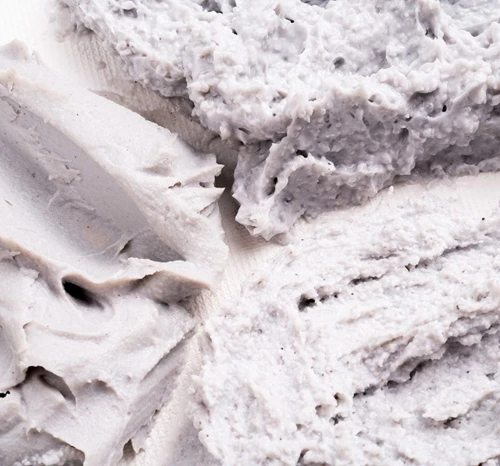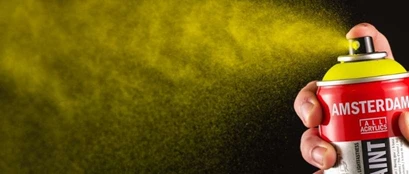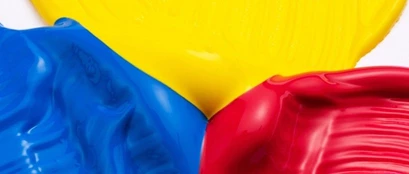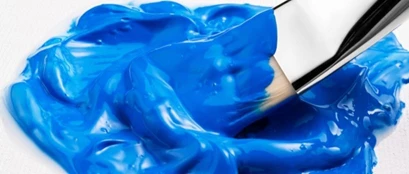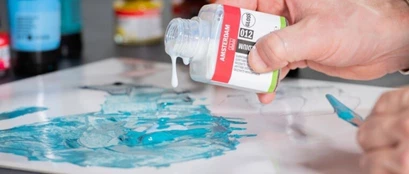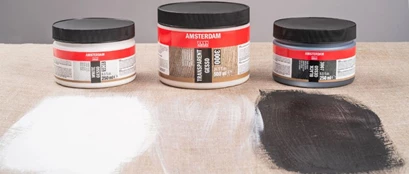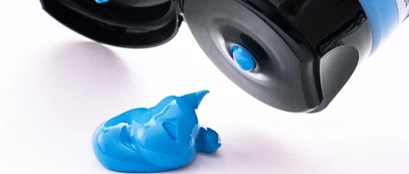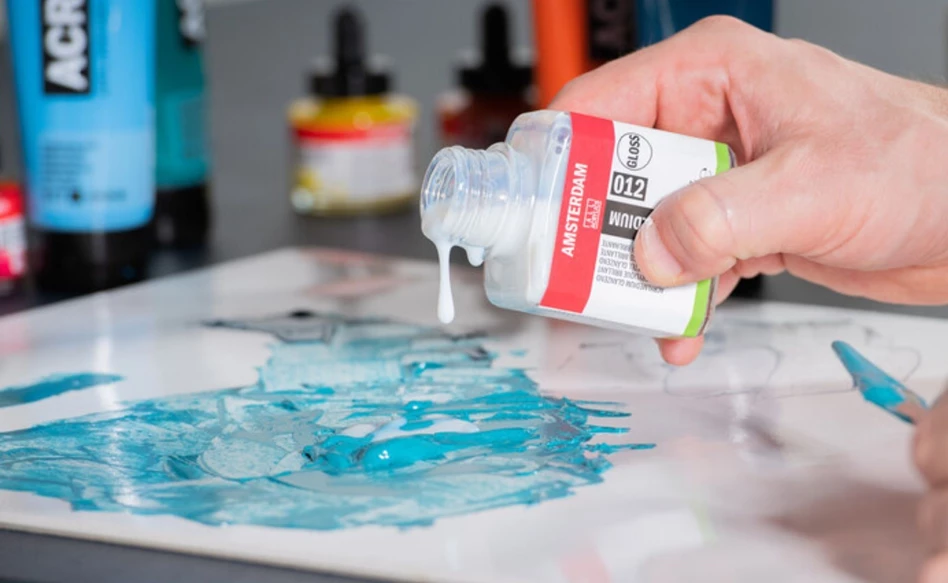
Acrylic painting mediums
Acrylic mediums are incredibly useful because they allow you to adjust the properties of the paint to your preferences. Whether you want to make your paint thicker, glossier, thinner or more matt, everything is possible with Amsterdam’s extensive assortment of mediums, ranging from slow drying to thickening and pouring mediums in different variations and sizes.
For special effects and textures, we offer an extensive range of effect mediums to choose from as well. Find out all you need to know about acrylic mediums in this blog!
Contents:
- How do I thin acrylic paint?
- Do acrylic mediums affect the color of the paint?
- How much acrylic medium can I add to my paint?
- How can I extend the drying time of acrylic paint?
- What medium can I use for acrylic pouring?
- How can I add more volume to acrylic paint?
- Can I use glazing techniques with acrylic paint?
- How can I add printed images to my work?
- What are special effect mediums?
How do I thin acrylic paint?
Acrylic colors can easily be thinned using water. If, however, you use large amounts of water, only a small amount of acrylic resin will be left on your work. The pigments will not be properly protected and might smudge once the water has evaporated. It also makes the paint film thinner and more fragile, which increases the risk of damage during transportation or when being wrapped up. Very thin paint may also have trouble adhering to certain surfaces. To prevent this from happening, thin your paint using Amsterdam acrylic medium!
An acrylic medium is indispensable for a great end result. Amsterdam acrylic medium adds acrylic resin to your paint to optimally protect the pigments and to help you easily spread your paint, while retaining the durability of the paint film. Your paint will last longer since it’s easier to distribute, so you can cover more of your surface with the same amount of paint. Adding more of this medium will result in higher transparency of the color.
Watch this video to see the difference between using pure acrylic paint, mixing it with water and using Amsterdam acrylic medium to thin the paint.
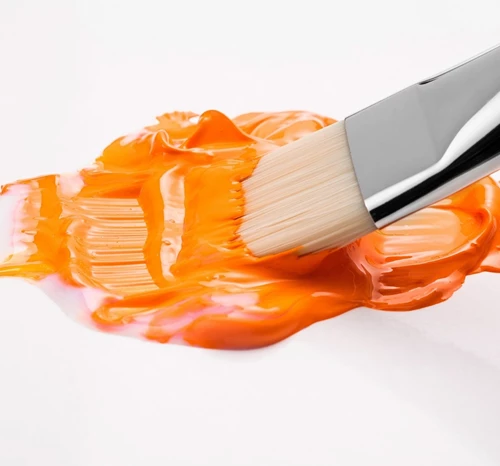
Do acrylic mediums affect the color of the paint?
The binder of acrylic paint and acrylic mediums consists of a dispersion of acrylic resin particles in water. These particles are transparent by themselves but appear milky in color because of the addition of water. Acrylic binder is thick, fluid and milky white while wet, but it dries colorless and transparent.
As long as the binder contains water, it will be white, but once the water has evaporated, the binder and the resin particles will form a colorless, transparent film and the white disappears. This explains why many acrylic paint colors appear lighter when you’ve just applied them. The same thing applies when you add a medium to your acrylic paint. When it’s still wet, the paint will appear lighter in color, but after drying, the color will be the same as pure dry paint.
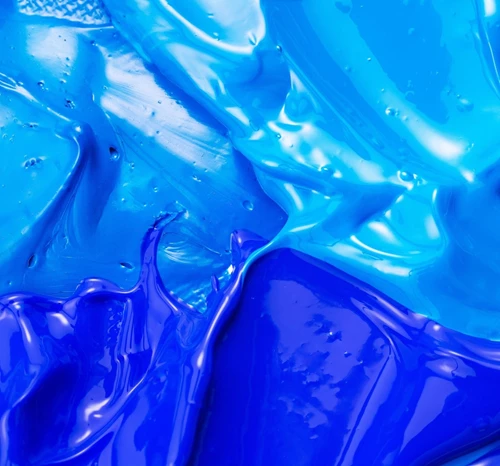
How much acrylic medium can I add to my paint?
Acrylic medium, pouring medium, glazing medium, slow drying medium and the gel mediums can be added to your paint in any quantity. Though mediums do not affect the color of the paint, they may affect its opacity. If you add a large amount of an acrylic medium to your paint, the pigments will be divided over a larger amount of acrylic binder. This means your color will become more transparent when you add more of the medium.
The only medium you need to be careful with is the acrylic retarder. You can only add a maximum of 5% of this medium to your paint.
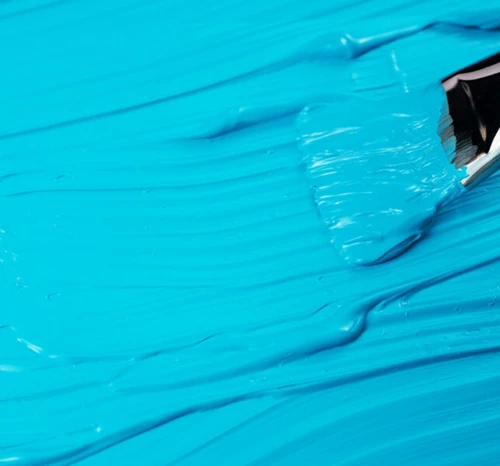
How can I extend the drying time of acrylic paint?
If you want to work alla prima, also known as direct painting or wet-on-wet, using acrylic colors, you need to act quickly as acrylic paint dries quite fast. Buy yourself some extra time to create stunning color transitions, blend colors smoothly and allow yourself to work on the same area for longer using Amsterdam slow drying medium or acrylic retarder.
What is the difference between Amsterdam slow drying medium and Amsterdam acrylic retarder?
Both products delay the drying time of acrylic paint with a maximum of 20%, the biggest difference being that the slow drying medium is a pre-mixed, ready-to-use medium that also contains acrylic resin, which makes it much easier and safe to use in any quantity. Like with any medium, adding a large amount will make the paint thinner and more transparent.
The acrylic retarder, on the other hand, has little effect on the viscosity and opacity of the paint. You should be careful adding the acrylic retarder to your paint, though, and only add a maximum of 5%. If you add too much, your paint will turn rubber-like and become unusable.
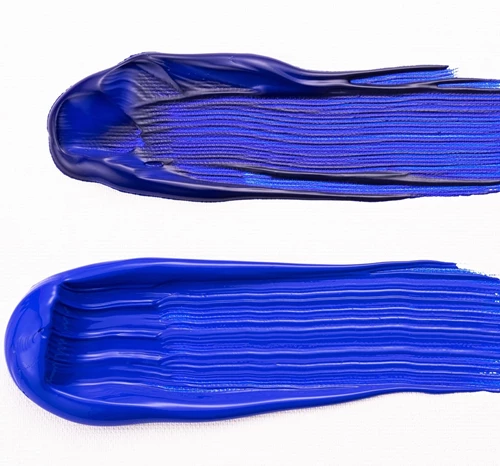
What medium can I use for acrylic pouring?
For acrylic pouring, we recommend adding Amsterdam pouring medium to your acrylic paint or ink. This medium is specifically developed to be self-leveling and increases the flexibility of the paint film to prevent cracking. Depending on the desired flow, you can adjust the mixing ratio to your liking. You can also add water to make the mixture even more fluid.
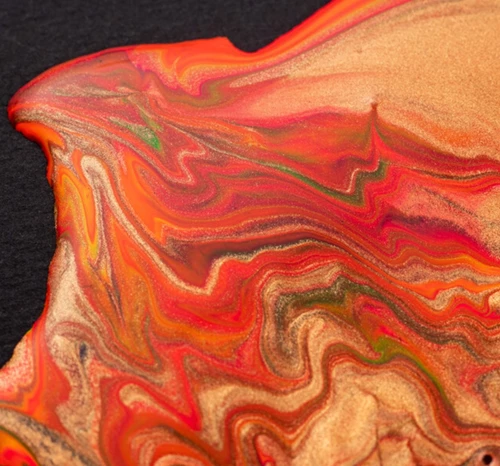
How can I add more volume to acrylic paint?
Gel mediums
If you’re looking for some extra volume and dimension, try mixing your acrylic colors with one of the Amsterdam gel mediums. These mediums offer a sharper, pastier texture and give your work, depending on the selected gel, a glossier or more matt finish. Due to their adhesive properties, these gels also work well for different mixed media techniques. Keep in mind that these mediums contain water, so they will lose volume during the drying process when the water evaporates.
These gel mediums are available in gel, heavy gel and extra heavy gel versions.
Watch this video to see these gel mediums in action!
Thickening medium
For a sharper, more visible brush stroke, add Amsterdam thickening medium to your paint. Create a luscious, thick consistency by adding just a small amount of this medium to your Amsterdam acrylic colors. This medium does not affect the color intensity or opacity of the paint since you only need a small amount. When using it, start by adding a very small amount to the paint and slowly add more if needed. Adding too much can create an unpleasant and gummy texture.
This video shows you how to use this medium.
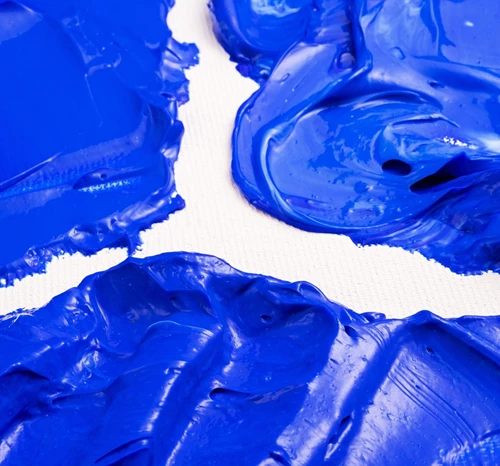
Can I use glazing techniques with acrylic paint?
Did you know you can use traditional glazing techniques with acrylic paint as well? Amsterdam glazing medium allows you to add those even, transparent layers to your work. This medium makes your paint smoother, easier to spread and more even (without visible brush strokes). The medium is self-leveling, so it helps you create those beautiful glazing layers to achieve an optical color mixing effect with the colors of the underlying layers. Glazing works especially well with transparent colors in the final layers of your painting. Adding a medium also makes the paint film even more elastic and flexible.
Watch this video to see Amsterdam glazing medium used in different amounts to influence the paint's transparency.
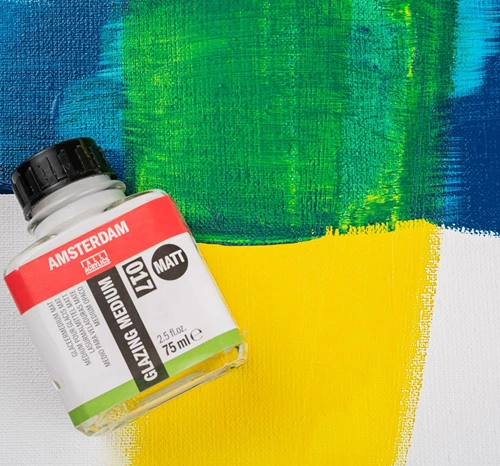
How can I add printed images to my work?
Amsterdam photo transfer gel has been specially developed to allow you to include laser-printed images in your work. The gel only works with laser-printed images, photographs and inkjet-printed images are not suitable.
How to use:
- Apply a layer of the transfer medium on the printed side of your laser-printed image or on the surface you’ll be working on. Note that the image will be mirrored when transferred, so if you want to work with text, don’t forget to mirror the image first!
- Place the printed side of the paper down on the surface you’re working on, press down firmly and carefully rub away any air bubbles. Let dry for at least 24 hours.
- Moisten the paper using a moist cloth or sponge. Use your fingers or a dry cloth to rub off all of the paper, revealing the transferred image. This image can be painted over immediately.
- For an optimal result, apply a glossy varnish or an acrylic medium on top to eliminate the white film that may appear.
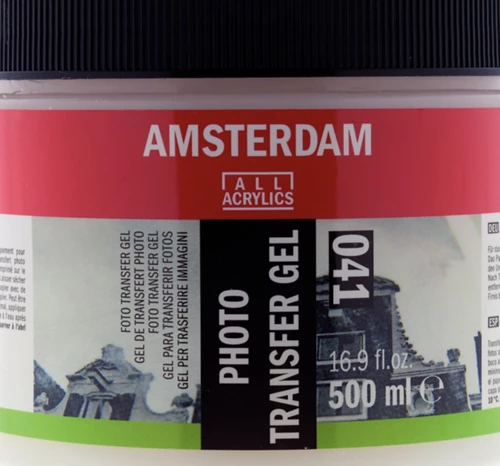
What are special effect mediums?
Besides all of the mediums mentioned above, Amsterdam offers various effect mediums that you can use directly from the jar or mix with different colors. These effect mediums, including pumice, glow in the dark, glitter and pearl mediums, allow you to add a whole new dimension to your work and make it even more eye catching.
Glitter flakes
Add some sparkle to your work with Amsterdam glitter flakes! Mix them with gloss mediums (such as acrylic, glazing or gel), transparent paints or use them on top of wet paint. Opaque paint and matt mediums or varnishes will dull the sparkle effect. Amsterdam flakes are available in multi-color (holographic) black, silver and gold.
How to use:
Carefully sprinkle or scoop the flakes from the jar. Avoid breathing in the particles; use respiratory protection if necessary. Apply the glitter on top of wet paint or mix it into mediums, varnishes or transparent paints. To increase the glitter effect, finish your work with a glossy varnish after 4 to 5 days. This will also help keep the glitter in place.
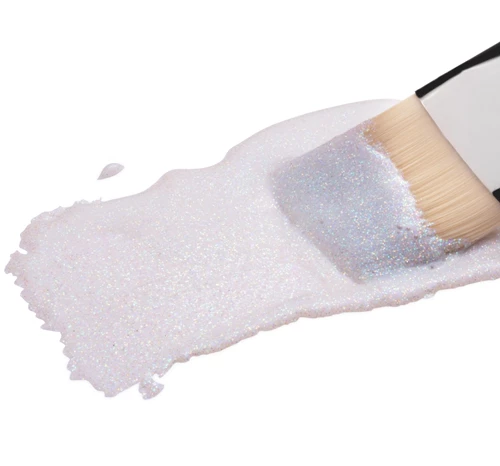
Glow in the dark
Add an extra dimension to your work with Amsterdam glow in the dark medium. Thanks to a phosphorescent pigment, areas painted with this medium will continue to glow in the dark long after their application. Do not mix this medium into acrylic paint, doing so will remove the glow-in-the-dark effect. Apply the glow in the dark medium as a final layer on your work for optimal results. This medium works especially well for murals!
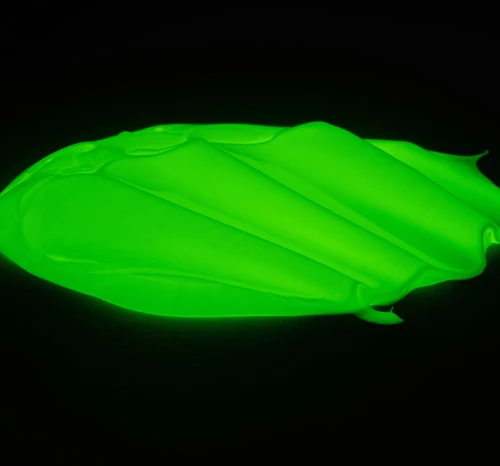
Pearl
Create new, interesting textures with Amsterdam pearl medium. This medium contains tiny round glass beads that, particularly in combination with transparent acrylic paint or in its pure form, create an attractive glass pearl texture. Amsterdam pearl medium is a great addition to any mixed media piece!
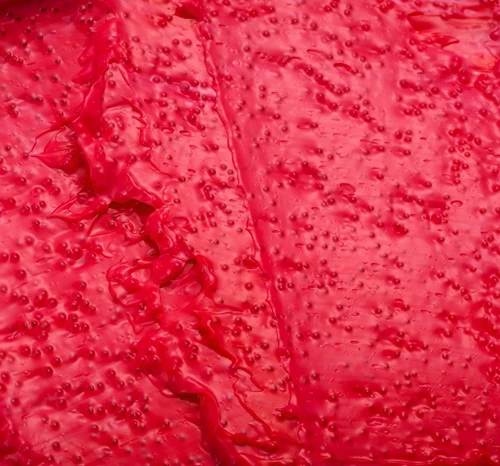
Pumice
Add a rough texture to your work with Amsterdam pumice medium. This pumice has a gray tone and can be used directly from the jar on its own, painted over or mixed with paint. Since the pumice medium is colored, mixing it with paint affects the color. Amsterdam pumice medium is available in fine, middle and coarse textures. Fine pumice medium is often used to create backgrounds to work on with pastels. The grainy texture significantly increases color deposit.
